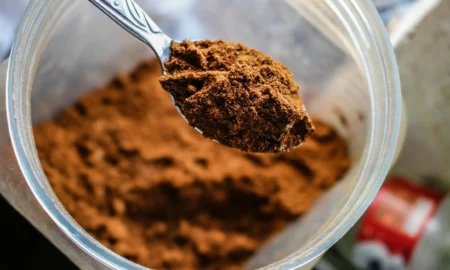Two new studies highlight the effectiveness of supplementing with creatine, especially for those engaged in bodybuilding. Creatine is an amino acid by-product, produced from three amino acids—arginine, methionine and glycine—in the liver, pancreas and kidneys. The basic function of creatine is to donate a phosphate molecule that reconstitutes depleted stores of adenosine triphosphate in muscle. That’s important because ATP is the immediate energy source for all muscular contraction. Creatine also interacts with anabolic hormones and plays a role in muscle protein synthesis. That means it has direct anabolic effects in muscle.
That was demonstrated in a recent study that examined the interactions between supplemental creatine and weight training on the production of insulinlike growth factor 1 in muscle. The liver produces IGF-1 after stimulation by growth hormone release. The systemic IGF-1 circulates in the blood, bound to six different proteins, but only the free form of IGF-1 is biologically active Two variants, or splices, of IGF-1 are also locally produced in muscle.
IGF-1 is vital for muscle repair and growth processes. It stimulates the activity of satellite cells, which are muscle stem cells used by the body to repair damaged muscle fibers. From a muscle hypertrophy point of view, muscle IGF-1 is of paramount importance. Young men and women show an average increase in blood IGF-1 of 20 percent after 13 to 25 weeks of resistance training. In older adults the increase is even more impressive, with one study showing a 500 percent rise in muscle IGF-1 after 10 weeks of lifting.
A study published in 2005 pointed to a link between creatine intake and higher IGF-1 measures in men who weight-trained. Twenty-four men and 18 women, all of whom had at least one year of weight-training experience, engaged in a structured exercise program for at least 30 minutes three to five times a week. None of the subjects had taken any form of creatine for six weeks prior to the start of the eight-week study. They were randomly assigned to either a creatine or placebo group. One group initially did a standard creatine load phase for seven days, taking an average of 16 grams daily followed by a maintenance phase in which they took four grams a day. Some of the subjects were vegetarians, and it was surmised that they would show the greatest gains with creatine use, as vegetarians have less creatine in their bodies than meat eaters. Meat is a rich natural source of creatine.
Lifting alone boosted IGF-1 by 67 percent, but those taking creatine experienced a 78 percent increase in muscle IGF-1. Those taking the placebo had less IGF-1 than the creatine group, thus pointing to a definite synergistic effect between lifting weights and taking creatine for pumping up the IGF-1 muscle response. As to why that occurred, the authors offer the plausible explanation that creatine permitted more intense training, which led to a greater production of muscle IGF-1.
Contrary to expectations, the vegetarian subjects didn’t make more IGF-1 gains than the others. That’s explained by the fact that they got about half as much protein as the other subjects, and protein intake has a direct relationship to IGF-1 synthesis. When you think about it, that finding underscores the importance of taking in creatine as well as more protein for those engaged in intense bodybuilding training.
Speaking of protein and creatine, another recently published study examined the use of both low-dose creatine and protein in men who lifted weights three days a week for 10 weeks. The men ranged in age from 59 to 77, and none had previously used creatine supplements. They were randomly divided into three groups that received:
1) 0.1 grams of creatine per kilogram of bodyweight and 0.3 grams protein per kilogram of bodyweight
2) Creatine alone
3) A placebo
The daily doses of creatine and protein averaged eight and 30 grams, respectively, and were taken only on training days. The researchers measured formaldehyde in the subjects’ bodies. While most familiar as an embalming chemical, formaldehyde is also a by-product of creatine metabolism. You could say that using creatine “preserves” gains, but studies show that in young men getting high-dose creatine phases—21 grams daily—formaldehyde production increases 348 percent.
The concern here is that it is toxic. Among other problems, it may damage the endothelial cells, which could lead to atherosclerosis and cardiovascular disease. In large doses formaldehyde is also a carcinogen.
Those in the creatine-and-protein group had a significantly greater lean mass gain than the creatine-alone group. The protein-and-creatine group also had a 25 percent increase in bench press strength but no strength gains on the leg press. Gains made by the older men in the study were comparable to gains made by younger men. In fact, the older men made slightly greater lean mass gains than their younger counterparts, even though the younger men ate about three times more protein. Those who got creatine only showed no greater lean mass gains than the placebo group. The authors suggest that the low dose of creatine—eight grams daily—might not have been enough to bring on lean tissue gains.
Creatine use also produced 4 percent fewer muscle-breakdown products. As for formaldehyde, none of the men taking creatine excreted more than those in the placebo group. Formaldehyde may be a factor only during creatine loading phases. Another thing to consider is that since loading phases typically last six or seven days, formaldehyde is not likely to produce any toxicity. Studies show that formaldehyde formation in the body is related to high stress. Having greater amounts of the stress hormone adrenaline fosters formaldehyde synthesis in the body—as does smoking. The good news is that older men can make significant muscular progress on lower doses of creatine, especially if they combine it with slightly more protein in the diet. IM
References
Burke, D.G., et al. (2008). Effect of creatine supplementation and resistance exercise training on muscle insulinlike growth factor in young adults. Int J Sports Nutr Exerc Metab. 18:389-398.
Candow, D.G., et al. (2008). Low-dose creatine combined with protein during resistance training in older men. Med Sci Sports Exerc. In press.




















You must be logged in to post a comment Login